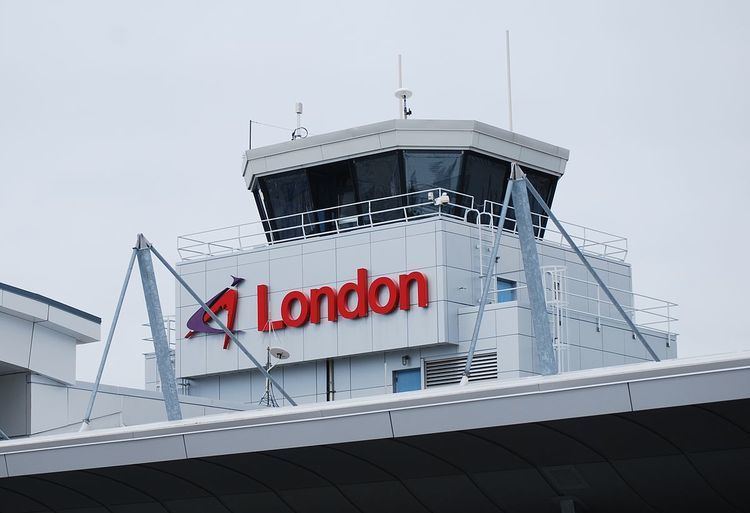Airport type Public Elevation AMSL 912 ft / 278 m Elevation 278 m Province Ontario | Code YXU Phone +1 519-452-4015 | |
 | ||
Operator Greater London International Airport Authority Address 1750 Crumlin Road, London, ON N5V 3B6, Canada Profiles | ||
London international airport update march
London International Airport (IATA: YXU, ICAO: CYXU) is located 5 nautical miles (9.3 km; 5.8 mi) northeast of the city of London, Ontario, Canada.
Contents
- London international airport update march
- London Airport 1929 1942
- London City Airport 1940 1945
- Postwar RCAF operations 1945 1961
- Development since 1950
- Other tenants
- Ground transportation
- Incidents
- References
In 2016, the airport handled 514,685 passengers, and, in 2011, was the 20th busiest in Canada in terms of aircraft movements, with 94,747. Air Canada Express, WestJet and WestJet Encore serve London International Airport. It also provides services for cargo airlines.
The airport is classified as an airport of entry by Nav Canada and is staffed by the Canada Border Services Agency (CBSA). CBSA officers at this airport can handle aircraft with no more than 180 passengers; however, they can handle up to 450 if the aircraft is unloaded in stages.
London Airport, 1929-1942
In January 1927 the City of London selected a site for an airfield at Lambeth, Ontario near 42°55′00″N 081°17′00″W. A group of local businessmen acquired the site in 1928 and by 3 May 1929 an airport license was issued to London Airport Ltd. The London Flying Club was formed in 1928 and became a tenant of the new airport. The airfield was used for flying instruction, private aviation, and for air mail. By 1933 it had become too small for some commercial aircraft.
The London Flying Club continued to use the Lambeth airfield until 7 August 1942.
London City Airport, 1940-1945
In 1935 the city decided to replace the original London Airport. Site surveys and consultations took place and on 9 September 1939, at the start of World War II, work began on a new airport located near Crumlin. The city leased the new airport to the Government of Canada, Department of Transport on 24 January 1940 for the duration of the war. Runways 14-32 and 05-23 were paved and ready for use by July 1940 and the Royal Canadian Air Force established RCAF Station Crumlin on part of the airport. This air station was host to No. 3 Elementary Flying School and No. 4 Air Observer School, both part of the British Commonwealth Air Training Plan.
The airport remained under civilian management and was used for civil and military aviation during the war years. The licence for London City Airport was issued on 6 May 1941. Improvements made during this time include:
Commonwealth Air Training Plan operations ended on 31 December 1944 with the closure of No. 4 Air Observer School.
After the war the airport remained under the control of the Department of Transport.
Postwar RCAF operations 1945-1961
After World War II RCAF reserve or auxiliary squadrons were given the task of defending Canada's major cities. 420 Squadron reformed as City of London 420 (Fighter) Auxiliary Squadron at the airport in September 1948. Initially equipped with Harvard aircraft, the squadron upgraded to Mustangs in 1952 and CT-133 jets in 1954. The squadron disbanded in 1957. Air Defence Command reformed 2420 Aircraft Control and Warning (Auxiliary) Squadron at London on 1 July 1956. 2420 trained Fighter Control operators and disbanded on 31 May 1961.
RCAF Station London opened in 1950 to support a NATO Induction and Training Centre, later moved to Centralia. The station closed on 30 September 1958.
As a tribute to this period, a Canadair T-33 aircraft in former Royal Canadian Air Force livery is mounted in front of the main terminal building.
Development since 1950-
The airport has been continuously improved since World War II as navigation and air traffic control systems evolved, and as commercial aircraft became larger and larger. These improvements include:
Other tenants
London International Airport Fire Crash and Rescue Station provides fire and rescue operations at the airport with three crash tenders based on Blair Boulevard.
Ground transportation
Shuttle service is available for passengers wishing to connect to flights at Toronto Pearson International Airport in Toronto.
